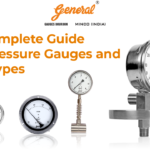Pressure switches are instruments present in a system where adequate pressure is an integral part of system operation. A pressure switch is activated when a predetermined pressure point is reached. The significance of pressure switches stems from their relevance in lowering the possibility of equipment or personnel hazards.
They are commonly used in commercial and residential settings to open or close an electrical switching element. High quality pressure switches have been demonstrated in worldwide onshore and offshore sectors for their accuracy, dependability, safety, and long product life cycle.
With so many different types of pressure switches on the market, selecting the right pressure switch for your application is critical. Selecting the wrong one can lead to system failure or even safety hazards.
In this blog, we will outline the steps and present to you a pressure switch selection guide to ensure that you choose the right pressure switch according to your application.
The following factors should always be considered when choosing the right pressure switch.
- Assess the process fluid type
- Identify the apt pressure range according to your application.
- Understand if the pressure switch can achieve your required setpoint
- Determine the working temperature
- Evaluate repeatability of pressure switches:
- Compare the various types of pressure switches
- Take into account the safety requirements and standards that apply to your industry
The following steps one must consider while chossing pressure switches:
Assess the process fluid type:
The primary consideration while choosing the right pressure switch is the type of fluid used in the pressure switch. The material used must be compatible with the materials of the pressure switches, which means it must be resistant to common chemical and physical attacks that can be induced by the application material.
Typical fluid types used with pressure switches are
- Hydraulic oil
- Turpentine
- Petrol
- Air
- Water
Identify the apt pressure range according to your application:
After the fluid type, the most crucial consideration is the pressure range. Determine that your pressure switch can not only handle your normal pressure range but also can also handle the pressure spikes in your application. Along with this, the type of pressure (vacuum or positive) must also be considered while choosing the pressure switch
Understand if the pressure switch can achieve your required setpoint:
Setpoint constraints must be addressed while selecting a right pressure switch. There are particular setpoints related with pressure switches, regardless of the kind. It is also necessary to establish whether your application entails the use of dual set points.Dual set points are required by any application that needs to be notified if the pressure is lower & higher than a certain point.
Determine the working temperature:
When choosing the pressure switches, its effectiveness according to temperature must be given imoirtance. Usually, there is a datasheet that typically lists the temperature specifications that a particular pressure switch can withstand. Exceeding a switch’s stated temperature limitations can result in safety risks.
Nitrile butadiene rubber (NBR) is a preferred material to work with medium temperature, when the element used is air or hydraulic oil. However, when the medium is water, ethylene propylene diene monomer rubber (EPDM) is considered to be better material. Flurosilicone rubber is preferred for applications that operate on higher temperature.
Also Read: Ultimate Guide to Selecting the Right Pressure Gauge
Evaluate repeatability of pressure switches:
The repeatability of the switches is their ability to offer the same setpoint time after time. Different styles of pressure switches have varied repeatability. Generally, electronic pressure switches tend to have better accuracies.
Compare the various types of pressure switches:
There are several types of pressure switches available, each tailored for a unique use. Along with identifying the right type of pressure switch to be used, it is also necessary to assess whether the pressure switch requires further calibration such as tags, wall/pipe mount, metric labelling, factory set (XFS) etc based on the application.You must also ensure that the switch’s end connection is compatible with your application.
Some common types of pressure switches to choose from include:
- Indicating Pressure Switches (Pressure Gauge with Switch)
- Indicating Differential Pressure Switches (Differential Pressure Gauge with Switch)
- Blind Pressure Switch
- Blind Differential ressure Switch
Also Read: 5 Detailed Applications for Pressure Sensors in Industry
Take into account the safety requirements and standards that apply to your industry:
In safety-critical applications, pressure switches that meet current industry standards and regulations are crucial. Look for gauges that have been authorised and, if necessary, are suitable for hazardous areas. This comprises both hazardous and industrial certifications such as explosion proof, non-incendive safety, boiler limit control approval, and so on. Determining which application is required varies according to the application of the switch in your industry.
Additionally, considerations such as the environment in which the pressure switch will be utilised should be taken into account to guarantee the safe operation of pressure switches. You must also examine what IP/NEMA ratings that you must meet. Pressure switch certifications such as UL, CSA, FM, CE, and others are available to improve the quality of pressure switches.
In conclusion, selecting the right pressure switches is critical for ensuring smoother operations. To assure quality and durability, choose a high quality instrumentation solution provider when choosing a pressure switches. Taking the effort to select the appropriate pressure switch for your application will result in improved performance.
The experts at General Instruments Consortium can assist you in finding the right pressure switch for your application.Contact us today to talk to one of our instrumentation expert.

